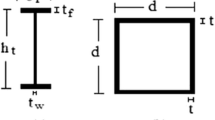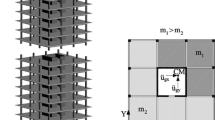Abstract
The drift pushover analysis method for tall and regular buildings is extended in this paper to the third dimension. The focus of study is on the structures with important torsional response. For this purpose, 10, 15, 20 and 30-story steel moment frame buildings having unsymmetrical plans with 5–30% eccentricity ratios are studied. For evaluation of accuracy, nonlinear dynamic response of the buildings is determined under a consistent suit of earthquake ground motions. The maxima of the story drifts and shears and cumulative plastic hinge rotations of stories are calculated under the ground motions and their averages along with those of the modal pushover procedure are compared with the results of the presented method. The comparative analysis establishes the good accuracy of the three dimensional drift pushover method.



















Similar content being viewed by others
References
Albanesi T, Biondi S, Petrangeli M (2002) Pushover analysis: an energy based approach. In: Proceedings of the twelfth European conference on earthquake engineering, London, United Kingdom, Paper No. 605
American Institute of Steel Construction (2010) Specification for structural steel buildings. ANSI/AISC 360-10, Chicago, IL
American Society of Civil Engineers (2010) Minimum design loads for buildings and other structures: Second Printing. ASCE7-10
American Society of Civil Engineers (2014) Seismic evaluation and retrofit of existing buildings. ASCE SEI 41-13
Antoniou S, Pinho R (2004) Development and verification of a displacement-based adaptive pushover procedure. J Earthq Eng 8:643–661
Behnamfar F, Taherian SM, Sahraei A (2016) Enhanced nonlinear static analysis with the drift pushover procedure for tall buildings. Bull Earthq Eng 14:3025–3046
Bracci JM, Kunnath SK, Reinhorn AM (1997) Seismic performance and retrofit evaluation of reinforced concrete structures. J Struct Eng ASCE 123:3–10
Chopra AK, Goel RK (2000) Evaluation of NSP to estimate seismic deformation: SDF systems. J Struct Eng ASCE 126:482–490
Chopra AK, Goel RK (2004) A modal pushover analysis procedure for estimating seismic demands for unsymmetric-plan buildings. Earthq Eng Eng Vib 33:903–927
Fajfar P, Marusic D, Perus I (2005a) Torsional effects in the pushover-based seismic analysis of buildings. J Earthq Eng 9(6):831–854
Fajfar P, Marusic D, Perus I (2005b) The extension of N2 method to asymmetric buildings. In: Proceedings of the 4th European workshop on the seismic behaviour of irregular and complex structures, Thessaloniki
Gupta B (1999) Enhanced pushover procedure and inelastic demand estimation for performance-based seismic evaluation of buildings, Ph.D. Dissertation, University of Central Florida, Orlando, FL
Gupta B, Kunnath S (1999) Pushover analysis of isolated flexural reinforced concrete walls. 1999 New Orleans Structures Congress
Mazzoni S, McKenna F, Scott M, Fenves G, Jeremic B (2006) Opensees command language manual. PacificEarthquake Engineering Research Center (PEER), University of California, Berkeley, California
Moghadam AS, Tso WK (2000a) Pushover analysis for asymmetric and set-back multi-story buildings. In: Proceedings of the 12th world conference on earthquake engineering, Auckland, New Zeeland
Moghdam AS, Tso WK (2000b) 3-D push-over analysis for damage assessment of buildings. J Seismol Earthq Eng 2(3):23–31
Pacific Earthquake Engineering Research Center (2016) PEER ground motion database. http://ngawest2.berkeley.edu/
Parducci A, Comodini F, Lucarelli M, Mezzi M, Tomassoli E (2006) Energy-based nonlinear static analysis. In: First European conference on earthquake engineering and seismology
Poursha M, Khoshnoudian F, Moghadam A (2009) A consecutive modal pushover procedure for estimating the seismic demands of tall buildings. Eng Struct 31:591–599
Requena M, D’Ayala G (2000) Evaluation of a simplified method for the determination of the nonlinear seismic response of RC frames. In: Proceedings of the twelfth world conference on earthquake engineering, Auckland, New Zealand, Paper No. 2109
Reyes JC, Chopra AK (2011a) Three-dimensional modal pushover analysis for buildings subjected to two components of ground motion, including its evaluation for tall buildings. Earthq Eng Eng Vib 40:789–806
Reyes JC, Chopra AK (2011b) Evaluation of three-dimensional modal pushover analysis for unsymmetric-plan buildings subjected to two components of ground motion. Earthq Eng Eng Vib 40:1475–1494
Sahraei A, Behnamfar F (2014) A drift pushover analysis procedure for estimating the seismic demands of buildings. Earthq Spectra 30:1601–1618
Tjhin T, Aschheim M, Hernández-Montes E (2005) Estimates of peak roof displacement using “equivalent” single degree of freedom systems. J Struct Eng ASCE 131:517–522
Tso WK, Moghadam AS (1997) Seismic response of asymmetrical buildings using push-over analysis. In: Proceedings of workshop on seismic design methodologies for the next generation of codes, Bled, Slovenia
Author information
Authors and Affiliations
Corresponding author
Rights and permissions
About this article
Cite this article
Karimi, M., Behnamfar, F. A three-dimensional drift pushover method for unsymmetrical plan buildings. Bull Earthquake Eng 16, 5397–5424 (2018). https://doi.org/10.1007/s10518-018-0322-z
Received:
Accepted:
Published:
Issue Date:
DOI: https://doi.org/10.1007/s10518-018-0322-z




